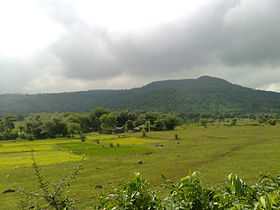Rajmahal hills
| Rajmahal hills | |
|---|---|
| Hills | |
|
Rajmahal Hills View | |
| Country |
|
| State | Jharkhand |
| Languages | |
| • Official | Hindi, Santali |
| Time zone | IST (UTC+5:30) |
Rajmhal Hills lie in Santhal Pargana of Jharkhand in India. It forms the northernmost tip of the famed Gondwana land, and is the abode of Sauria Paharia and the Santhal tribes.
Fossils belonging to the Jurassic period[1] possibly dating back 150-200 million years were found along these hills, which are also called as Rajmahal Traps
Rajmahal Hills (Rājmahal Hills) is a hills (class T - Hypsographic) in State of Jharkhand (Jharkhand), India (Asia) with the region font code of Asia/Pacific. It is located at an elevation of 333 meters above sea level.
Its coordinates are 24°40'0" N and 87°25'0" E in DMS (Degrees Minutes Seconds) or 24.6667 and 87.4167 (in decimal degrees). Its UTM position is WH42 and its Joint Operation Graphics reference is NG45-15.The standard time zone for Rajmahal Hills is UTC/GMT+5.5 In 2014 DST starts on - and ends on -.
A Hills is rounded elevations of limited extent rising above the surrounding land with local relief of less than 300m.
The Rajmahal Hills are named after the town of Rajmahal which lies in the east of Jharkhand. The hills are pointed in a north-south axis with an average elevation of 200-300 metres(600-1000 feet) above mean sea level. It starts from Sahibganj district and ends up in Dumka district. The River Ganges wanders around the hills changing the direction of flow from east direction to south direction. The hills span over an area of one hundred and twenty miles.
The upper regions of the Rajmahal hills are inhabited by the Sauria Pahariya tribe while the valleys are dominated by the Santhal tribe who use the land for cultivation.
FOSSILS IN RAJMAHAL HILLS
Around 1946, palaeobotanist Birbal Sahani, who studied fossils of the subcontinent, would often hop off a goods train after asking its driver to slow down near Sahebganj — not connected by passenger train then — and walk into the Rajmahal hills in pursuit of the past.
Sixty-two years later, Sahani’s dream of seeing a fossil park in Rajmahal is fast turning into reality. The area which the botanist — who later founded Lucknow’s Institute of Palaeobotany now named after him — had so meticulously researched would be home to eastern India’s first fossil park.
Some of the oldest fossils belonging to the Jurassic and Lower Cretaceous period, dating back 150-200 million years, will be preserved in this park.
An MoU was signed in January between the Jharkhand government, Birbal Sahni Institute of Palaeobotany (BSIP), Lucknow, and the National Building Construction Corporation (NBCC) for the project. The institute, which will provide the technological knowhow, submitted a detailed project report to the state government in May.
“There is an urgent need to conserve the rich fossil site. It is essential to preserve the plant fossils in ancient conditions,” the report states.
